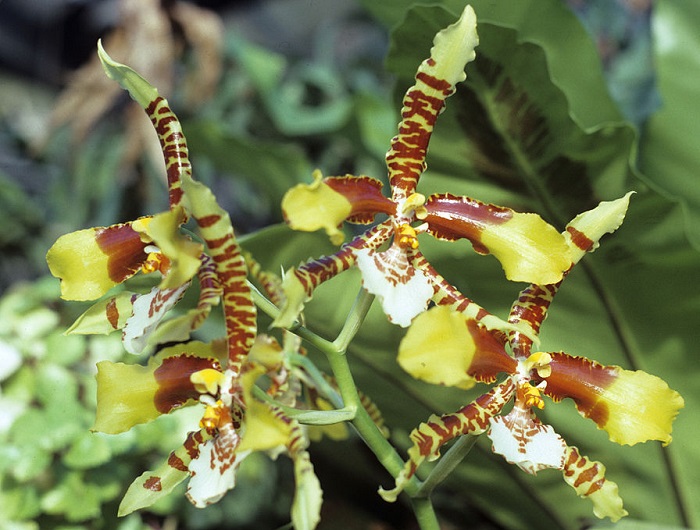Tiger Orchids
Botanical Name: Rossioglossum grande
Tiger orchids originate from the high elevations of tropical America, where they thrive in the cool, misty mountain air. Keep them cool with plenty of humidity, and you'll enjoy these spectacular orchids a long time.
Rossioglossum grande orchids were formerly known as Odontoglossum grande and sometimes labeled with that name.
 Rossioglossum Rawdon Jester is a boldly colored hybrid that blooms in autumn and winter.
Rossioglossum Rawdon Jester is a boldly colored hybrid that blooms in autumn and winter.Get to Know Tiger Orchids
These tropical orchids are epiphytic and have fat, egg-shaped pseudobulbs. A pair of long, narrow arching leaves grow from each pseudobulb. Young leaves are often speckled with brown -- this is normal, though many may mistake those brown spots for an insect infestation.
How tall do tiger orchids get? Flower stems can grow to 12 in (30 cm) tall, each branched stem carrying several large blooms. And those flowers are stunning. Each vibrant bloom can grow up to 6 in (15 cm) wide, made up of golden-yellow petals and sepals with tiger-like reddish brown stripes.
No flowers? Your orchids aren't getting enough light. See "Light" below. Rossioglossum orchids typically won't flower until summer, so be patient. One hybrid, Rossioglossum Rawdon Jester (shown above) begins blooming in autumn.
Tiger Orchids love humidity. Native to Southern Mexico and Guatemala, these tropical beauties grow in nature bathed in high humidity. If the relative humidity drops below 50%, use a humidity tray or a cool-mist room humidifier. Grouping plants also helps to maintain the moisture in the air around them.
Wondering whether to repot? Repot your orchid every couple years because the medium breaks down and doesn't allow air to get to the orchid's roots. Use a fairly small pot (around 4- or 6-inch (10-15 cm)) because these beauties grow best when they are a little crowded. Using a terracotta pot or an orchid pot with holes in it helps to dry out the medium faster and prevents root rot. The best time to repot is when new growth begins.
Green Thumb Tip
It's a good idea to thoroughly soak roots before repotting so that the roots are less brittle and less apt to break.
Although R. grande is not the easiest orchid to grow indoors, those big yellow-and-red striped blooms make them irresistible to orchid growers and worth accommodating its needs.
Tiger Orchid Care Tips
Light: Put your orchid where it'll get plenty of light, but out of hot, direct sun. If you don't have a spot near a window, indoor plant lights work beautifully. Place orchids about 8 inches (20 cm) beneath the light for 14-16 hours a day. It's also important to give them darkness at night. Plants need a rest, too.
Water: Water from the bottom to avoid getting pseudobulbs and leaves wet. Stand pot in room-temperature, lime-free water for about 20 minutes, or until medium is thoroughly moist. Allow the top inch (2.5 cm) to dry out before watering again. In winter, water just enough to prevent the potting medium from drying out completely. These orchids have water-storing pseudobulbs, making them more tolerant of dry medium than wet.
Humidity: Moderate to high, preferably 50-70% relative humidity. It's a good idea to use a humidity tray or room humidifier. Don't use a terrarium. Tiger Orchid likes free-flowing air as in its native high-mountain habitat. Put it where it'll enjoy plenty of air circulation.
Temperature: Aim to maintain fairly cool temps year-round (50-65°F/10-18°C). These cool mountain natives won't thrive in high temperatures.
Soil: Orchid potting mix will allow fast drainage to prevent root rot.
Fertilizer: Feed every 2 weeks with an orchid fertilizer while plant is growing and flowering.
Propagation: Divide large clumps by cutting through a rhizome, each piece should have pseudobulbs attached. Pot each rhizome separately in orchid potting mix.


